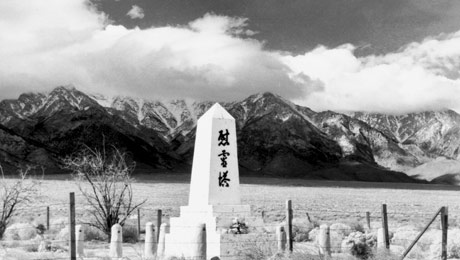Back to Asian Americans on Celluloid Timeline
Manzanar (1972)
Director and Writer: Robert A. Nakamura
Length: 16 minutes
View the film on:

Synopsis
Manzanar is a short documentary film by Robert Nakamura about his reflections on visiting the Manzanar War Relocation Camp, where he was interned from the ages of five to seven. The footage is mostly originally shot by Nakamura with a handheld camera. The original footage is juxtaposed with archival footage and mostly government images from the period. The soundtrack is (uncredited) Japanese classical and folk music.
Three short voice-over narrative segments recall “feelings, sounds, smells” Nakamura had while interned. At the climax of the film, we see jerky footage shot by someone who is walking away from the camp and then speeding up into a run as the music increases in intensity. Then, all of a sudden, it cuts to footage of the memorial and the Japanese inscriptions with quieter music.
Significance
Robert Nakamura filmed Manzanar while he was a student at UCLA’s film school and was part of the Ethno-Communications program. While we have a wider understanding of Japanese American internment today, this film may have been one of the earliest media depictions, excluding the government Japanese Relocation films during WW II.
In one of the voice-over segments, Nakamura describes how his parents “seemed fairly cheerful,” but understood while making the film that they were trying to “keep up a front.” This is a common experience that curator Karen Ishizuka states internees experienced, and the Japanese American phrase–shikataganai (literally, “nothing can be done” or “it can’t be helped”)–is reflective of that.
We are fortunate the Japanese American response to internment can be and has been documented as this can give us some perspective of how some Americans have different sets of rights and expectations depending on historical circumstances.
The filmmaker
Robert A. Nakamura was born in Venice, California in 1936 to an Issei father and Nisei mother. He is often referred to as “the Godfather of Asian American media.” With Alan Ohashi, Eddie Wong, and Duane Kubo, Nakamura co-founded the non-profit Visual Communications, which was created to “promote intercultural understanding through the creation, presentation, preservation and support of media works by and about Asian Pacific Americans.” His other films include:
- Wataridori: Birds of Passage (1975)
- Hito Hata: Raise the Banner (1980)
- Fool’s Dance (1980)
- Moving Memories (1993)
- Looking Like the Enemy (1995)
- Toyo Miyatake: Infinite Shades of Gray (2002)
Back to Asian Americans on Celluloid Timeline
Further reading and listening
Interviews with Robert A. Nakamura
- Bob Nakamura: Oral History. http://www.aasc.ucla.edu/aasc50/cm_bobnakamura.aspx
- Discover Nikkei: Robert A. Nakamura Interview. http://www.discovernikkei.org/en/interviews/profiles/144/
About Japanese Internment Camps
- Japanese Internment Camps. https://www.history.com/topics/world-war-ii/japanese-american-relocation
- Manzanar National Historic Site. https://www.nps.gov/manz/index.htm
- The Unlikely Story Behind Japanese Americans’ Campaign For Reparations. https://www.npr.org/sections/codeswitch/2020/03/24/820181127/the-unlikely-story-behind-japanese-americans-campaign-for-reparations
About Japanese Americans and Hollywood
- Japan’s 70-year struggle against Hollywood film stereotypes. https://japantoday.com/category/features/kuchikomi/japans-70-year-struggle-against-hollywood-films-stereotypes
- America’s Racial Limits: U.S. Cinema and the Occupation of Japan. http://www.jaas.gr.jp/jjas/PDF/2012/07_139-162.pdf
